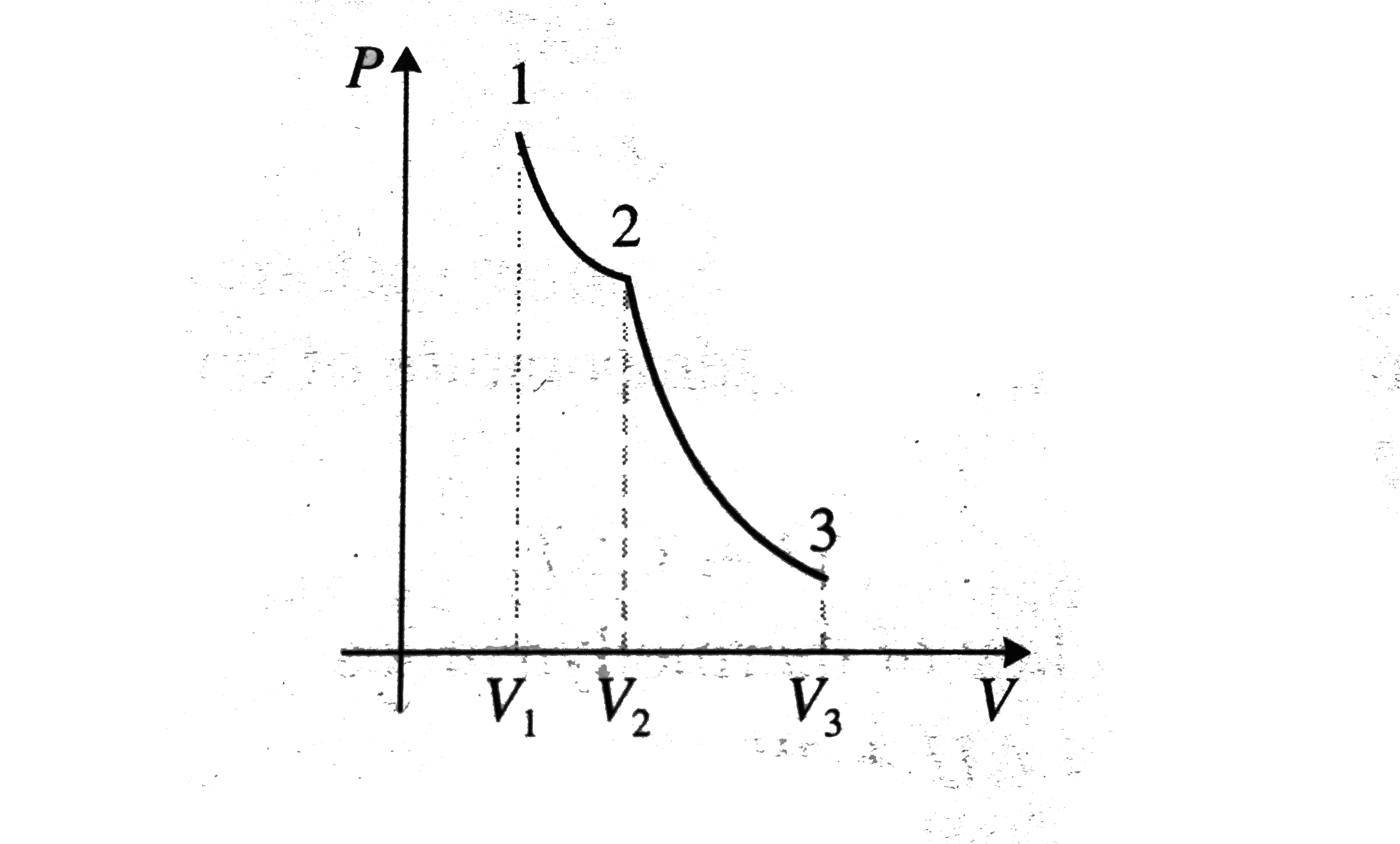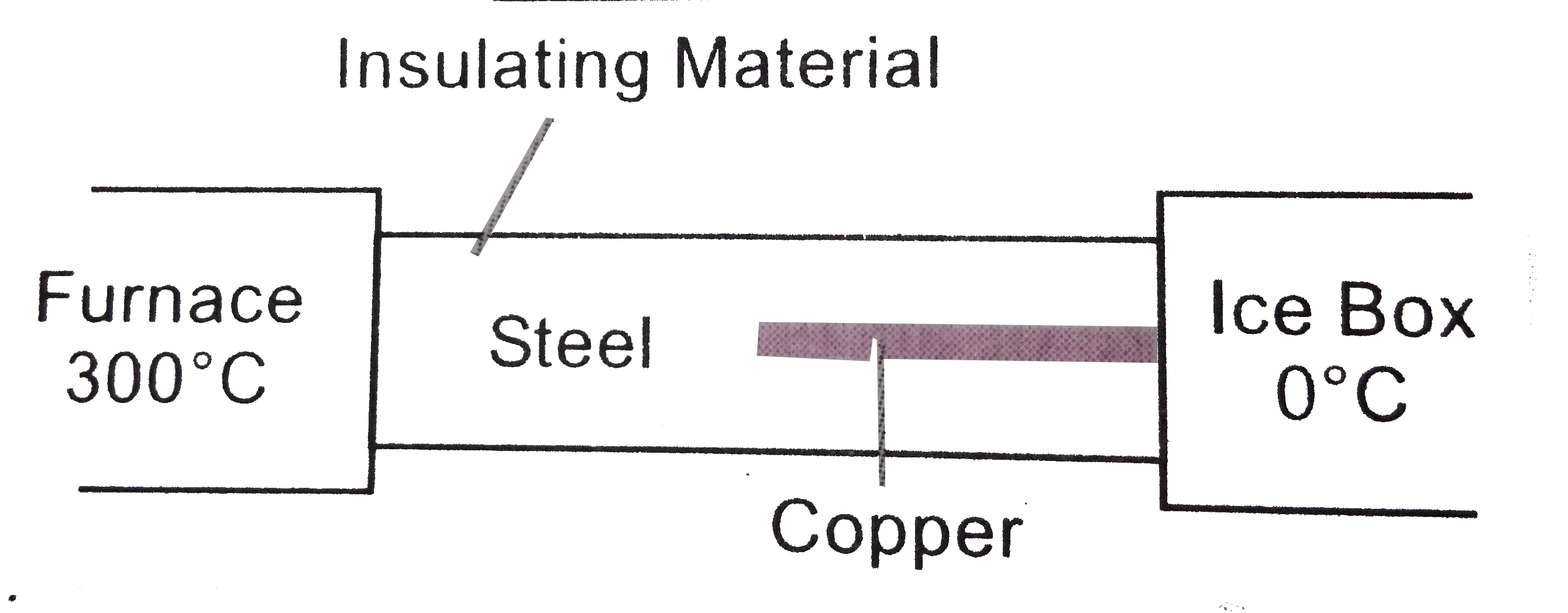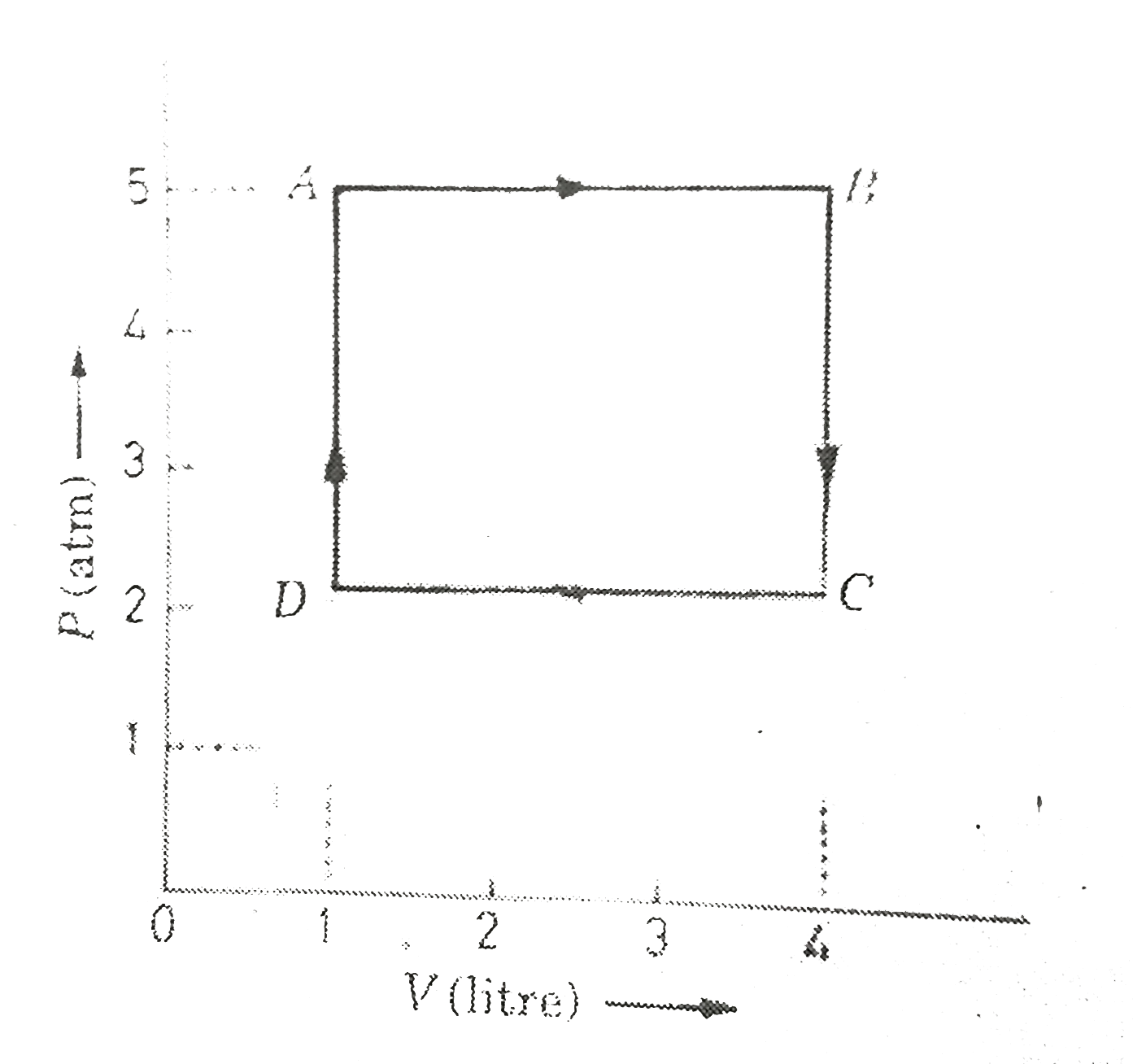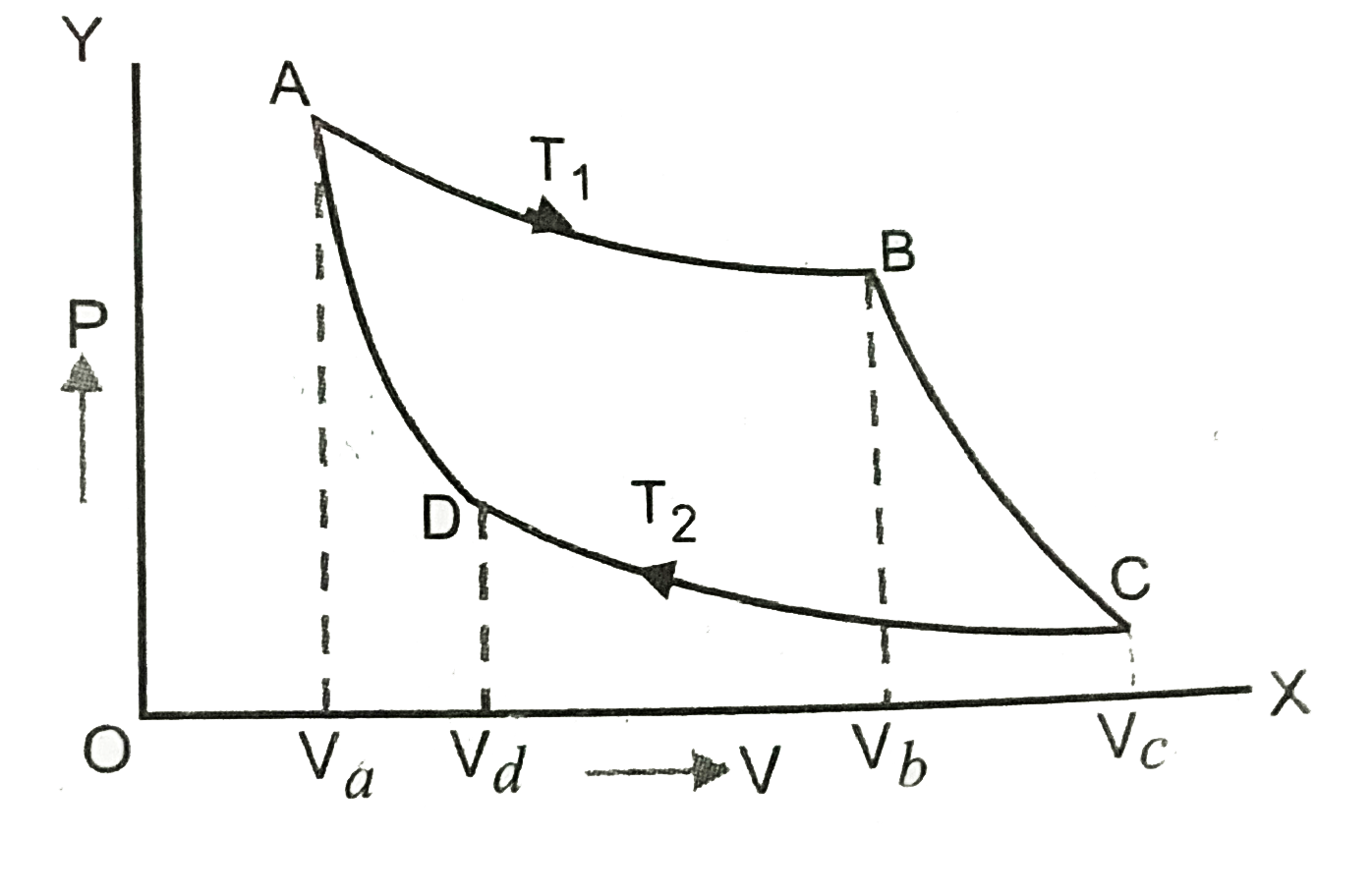Example from DHANPAT RAI & CO PHYSICS Chapter 23 THERMODYNAMICS for Class 11
| Class 11 | PHYSICS |
| Chapter | THERMODYNAMICS |
| DHANPAT RAI & CO PHYSICS | Example |
| Medium | English |
| Academic Year | 2023-2024 |
Question 2
The P−V diagram for a cyclic process is a triangle ABC drawn in order (figure). The co-ordinates of A,B,C are (4,1),(2,4)and(2,1) respectively. The co-ordinates are in the order (P,V) Pressure is in Nm−2 and volume is in liter. Calculate work done during the process from A to B, B to C and C to A. Also, calculate work done in the complete cycle.View SolutionQuestion 5
1.0m3 of water is converted into 1671m3 of steam at atmospheric pressure and 100∘C temperature. The latent heat of vaporisation of water is 2.3×106Jkg−1. If 2.0 kg of water be converted into steam at atmospheric pressure and 100∘C temperature, then how much will be the increases in its internal energy? Density of water 1.0×103kgm−3, atmospheric pressure =1.01×105Nm−2.View SolutionQuestion 9
A cyclinder with a movable piston contains 3mols of hydrogen at standard temperature and pressure. The walls of the cyclinder are made of a heat insulator, and the piston is insulated by having a pile of sand on it. By what factor does the pressure of the gas increases, if the gas is compressed to half its original volume? Given γ=1.4.View SolutionQuestion 10
The compression ratio of a certain diesel engine is 15. this means that air the cylinder is compressed to 1/15 of its initial volume. If the initial pressure is 1.0×105 Pa and the initial temperature is 300 K, find the final pressure and temperature after compression. air is mostly a mixture of oxygen and nitrogen and γ=1.4View SolutionQuestion 24
One mole of a perfect gas, initally at a pressure and temperature of 105N/m2 and 300 K, respectively, expands isothermally unitl its volume is doubled and then adiabatically until its volume is again doubled. Find final pressure and temperature of the gas Find the total work done during the isothermal and adiabatic processes. Given γ=1.4. Also draw the P-V diagram for the process.
 View Solution
View SolutionQuestion 34
An ideal engine operates by taking in steam from a boiler at 327∘C and rejecting heat to a sink at 27∘C. The engine runs at 500r± and heat taken is 600kcal in each revolution. Calculate(i) efficiency of engine (ii) work done in each cycle (iii) heat rejected in each revolution and (iv) power output of engine.View SolutionQuestion 35
During isothermal expansion at 800 K, the working substance of a Carnot's engine extracts 480 cal of heat. If the sink be at 300 K, calculate (i) the work done by the working substance during isothermal expansion (ii) the work done on the substance during isothermal compression (iii) the efficiency of the ideal engine.View SolutionQuestion 38
Two carnot engines A and B are operates in series. The first one A receives heat at 800 K and rejects to a reservoir at temperature TK. The second engine B revives the heat rejected to a heat reservoir at 300 K. calculate the temperature TK for the following cases.
(i) When the outputs of the two engines are equal.
(ii) When the efficiencies of the two engines are equal.View SolutionQuestion 49
A carnot engine having a perfect gas aas the working substance is driven backwards and is used for freezing water already at 0∘C. If the engine is driven by 500W electric motor with an efficiency of 60% how long will it take to freeze 15kg of water? The working temps of the engine are 15∘C and 0∘C. The system involves no energy losses. Given latent heat of ice =333×103Jkg−1.View SolutionQuestion 50
Heat is flowing through a rod of length 25.0cm having cross-sectional area 8.80cm2. The coefficient of thermal conductivity for the material of the rod is K=9.2×10−2kcals−1m−1.∘C−1. The Temperatures of the ends of the rod are 125∘C and 0∘C in the steady state. Calculate (i) temeprature gradient in the rod (ii) temperature of a point at a distance of 10.0cm from the hot end and (iii) rate of flow of heat.View SolutionQuestion 52
A brass boiler has a base area of 0.15m2 and thickness 1.0 cm it boils water at the rate of 6.0kg/min, When placed on a gas. Estimate the temperature of the part of the flame in contact with the boiler. Thermal conductivity of brass=109J/s−.∘C ) and heat of vapourization of water =2256J/g.View SolutionQuestion 54
A metal rod of length 20 cm and diamter 2 cm is convered with a non conducting substance. One of its ends is maintained at 100∘C , while the other end is put at 0∘C. It is found that 25 g ice melts in 5 min. calculate the coefficient of thermal conductivity of the metal. Latent that of ice = 80calg−1.View SolutionQuestion 57
Two vessels A and B of different materials but having identical shape, size and wall-thickness are filled with ice and kep at the same plane. Ice melts at the rate of 100g−1min and 150g−1min in A and B respectively. Assuming that heat enters the vessels through the walls only, calculate the ratio of thermal conductivity of their materials.View SolutionQuestion 58
Two plates of equal areas are placed in contact wih each other. Their thickness are 2.0 cm and 5.0 cm respectively. The temperature of the external surface of the first plate is −20∘C and that of the external surface of the second plate is 20∘C. What will be the temperature of the current surface if the plates (i) are of the same material, (ii) have thermal conductivities in the ratio 2:5.View SolutionQuestion 59
Three bars of equal lenghts and equal area of cross-section are connected in series. Their thermal conductivities are in the ratio of 2:4:3. If the open ends of the first and the last bars are at temperature 200∘C and 180∘C respectivity in the steady state, calculate the temperature of both the junctions.View SolutionQuestion 60
Heat is supplied to a slab of cork, 5cm thick and of 2m2 by a heating coil spread over its surface. When the current in the coil is 1.18 A and the potential difference across its end is 20 V, the steady temperatures of the faces of the slab are 12.5∘C and 0∘C. Assuming that the whole of the heat developed in the coil is conducted through the slab, calculate the thermal conductivity of the cork.View SolutionQuestion 61
What is the temperature of the steel-copper junction in the steady state system show in Fig. 7(e).17? Length of steel rod = 15.0 cm, length of the copper rod = 10.0 cm, temperature of the furnace =300∘C, temperature of other end 0∘C. The are of cross-section of the steel rod is twice that of the copper rod. (Thermal conductivity of steel =50.2js−1m−1K−1 and of copper =3895js−1m−1K−1).
 View Solution
View SolutionQuestion 88
One mole of an ideal gas undergoes a cyclic change ABCD where the (P,V) co-ordinates are A (5,1), B (5,3), C (2,3) and D (2,1). P is atmosphere and V is in litre. Calculate work done along AB, BC, CD and DA and also net work done in the process. Given 1atmosphere=1.01×105Nm−2. View SolutionQuestion 92
1.0m3 of water is converted into 1671m3 of steam at atmospheric pressure and 100∘C temperature. The latent heat of vaporisation of water is 2.3×106Jkg−1. If 2.0 kg of water be converted into steam at atmospheric pressure and 100∘C temperature, then how much will be the increases in its internal energy? Density of water 1.0×103kgm−3, atmospheric pressure =1.01×105Nm−2.View SolutionQuestion 95
A metal of mass 1 kg at constant atmospheric pressure and at initial temperature 20∘C is given a heat of 20000J. Find the following
(a) change in temperature,
(b) work done and
(c) change in internal energy.
(Given, specific heat =400J/kg−∘C, cofficient of cubical expansion, γ=9×10−5/∘C, density ρ=9000kg/m3, atmospheric pressure =105N/m2)View SolutionQuestion 105
An ideal gas has a specific heat at constant pressure CP=5R2. The gas is kept in a closed vessel of volume 0.0083m3, at a temperature of 300K and a pressure of 1.6×106N/m2. An amount of 2.49×104 Joules of heat energy is supplied to the gas. Calculate the final temperature and pressure of the gas. View SolutionQuestion 119
The compression ratio of a certain diesel engine is 15. this means that air the cylinder is compressed to 1/15 of its initial volume. If the initial pressure is 1.0×105 Pa and the initial temperature is 300 K, find the final pressure and temperature after compression. air is mostly a mixture of oxygen and nitrogen and γ=1.4View SolutionQuestion 144
An ideal engine operates by taking in steam from a boiler at 327∘C and rejecting heat to a sink at 27∘C. The engine runs at 500r± and heat taken is 600kcal in each revolution. Calculate(i) efficiency of engine (ii) work done in each cycle (iii) heat rejected in each revolution and (iv) power output of engine.View SolutionQuestion 145
Two Camot engines A and B are operated in series. The first one, A , receives heat at T1(=600K) and rejects to a reservoir at temperature T2. The second engine B receives heat rejected by the first engine and, in turn, rejects to a heat reservoir at T3(=400K). Calculate the temperature T2 if the work outputs of the two engines are equal :View SolutionQuestion 153
A carnot engine having a perfect gas aas the working substance is driven backwards and is used for freezing water already at 0∘C. If the engine is driven by 500W electric motor with an efficiency of 60% how long will it take to freeze 15kg of water? The working temps of the engine are 15∘C and 0∘C. The system involves no energy losses. Given latent heat of ice =333×103Jkg−1.View SolutionQuestion 156
Explain why
(a) Two bodies at different temperature T1andT2 if brought in thermal contact do not necessarily settle to the mean temperature (T1+T2)/2 ?
(b) The coolant in a chemical or nuclear plant (i.e., the liquid used to prevent different parts of a plant from getting too hot)should have high specific heat. Comment.
(c) Air pressure in a car tyre increases during driving . Why?
(d) The climate of a harbour town is more temperature (i.e., without extremes of heat and cold) than that of a town in a desert at the same latitude. Why?View SolutionQuestion 157
Explain why
(a) Two bodies at different temperature T1andT2 if brought in thermal contact do not necessarily settle to the mean temperature (T1+T2)/2 ?
(b) The coolant in a chemical or nuclear plant (i.e., the liquid used to prevent different parts of a plant from getting too hot)should have high specific heat. Comment.
(c) Air pressure in a car tyre increases during driving . Why?
(d) The climate of a harbour town is more temperature (i.e., without extremes of heat and cold) than that of a town in a desert at the same latitude. Why?View SolutionQuestion 160
A cyclinder with a movable piston contains 3mols of hydrogen at standard temperature and pressure. The walls of the cyclinder are made of a heat insulator, and the piston is insulated by having a pile of sand on it. By what factor does the pressure of the gas increases, if the gas is compressed to half its original volume? Given γ=1.4.View SolutionQuestion 161
In changing the state of a gas adiabatically from an equilibrium state A to another equilibrium state B, an amount of work equal to 22.3J is done on the system. If the gas is taken from State A to B via a process in which the net heat absorbed by the system is 9.35cal., How much is the net work done by the system in the later case? (Take 1cal.=4.9J)View SolutionQuestion 162
Two cyclinder A and B of equal capacity are connected to eachother via a stopcock. The cyclinder A contains an ideal gas at standard temperature and pressure, while the cyclindr B is completely evacuated. The entire system is thermally insulated. The stopcock is suddenly opened. Answer the following:
(a) What is the final pressure of the gas in A and B?
(b) What is the change in internal energy of the gas?
(c ) What is the change in temperature of a gas?
(d) Do the intermidiate states of the system (before settling to the final equilibrium state)lie on its P−V−T surface?View Solution


